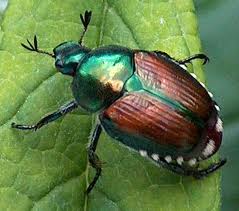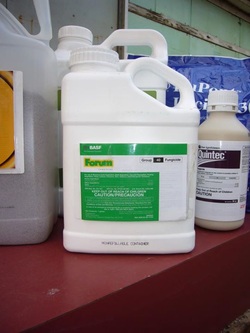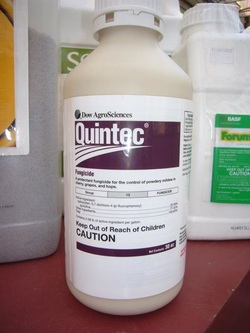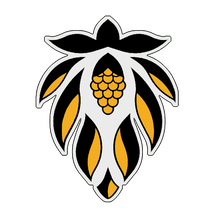 Japanese beetles are proving to be a formidable foe in hop yards located in the Great Lakes region. The beetles can cause significant damage to hop foliage and bines in a very short period of time if left uncontrolled. Two beetles can strip a large hop leaf in a single day and when their numbers reach the thousands, the beetles can strip a hop yard in just a few days. Organic hop growers find controlling them especially frustrating because they cannot apply the synthetic chemical controls commonly utilized. Here are some control strategy tips for all hop growers – organic and non-organic. First concept: Beetles attract more beetles. I do not consider Japanese beetles to be a threshold control-type pest where the decision to spray is based on tolerating a certain level of pests before treatment or spraying is done. Female beetles excrete pheromones to attract males and mating is a gregarious affair – a “beetle orgy” for lack of a better term. Beetles fly into the wind and follow the beetle pheromone trail to the plants and leaves where feeding and mating occur. Females apparently leave pheromones on the leaves; as I note that beetles arrive and continue to congregate on the same leaves – even if the original beetles are removed. However, a good hard rainfall seems to wash away this residual pheromone trail. It is well known that hanging pheromone traps can attract large number of both male and female beetle from great distances. A population of mating beetles will grow exponentially as congregating beetles emit stronger pheromone trails for newcomers to follow to the orgy – just like a pheromone trap. Allowing the beetles to establish a population in a hop yard is exactly like hanging pheromone traps in the middle of your hop yard.  Forum is a systemic protectant fungicide made by BASF that has some curative properties for the control of Downy mildew in hopyards. Like most fungicides, it works best if it is applied before the conditions for disease to develop occur. It carries a caution label rating and can be applied up to 7 days before harvest, 3 times per season total. Compatible with most other fungicides and insecticides in a tank mix. Forum is one of the only systemic fungicides with antisporulant activity that fights sporangia before the fungalspores have a chance to form and produce destructive zoospores that infect tubers and leaves.The spore-stopping effect of Forum can control the further spread of downy mildew in already infected fields. Forum's active ingredient is dimethomorph. This class of fungicides is very susceptible to build up of resistant downy mildew. It should only be applied in rotation with other mode of action (MOA) fungicides and never twice in a row without another fungicide. It cannot be applied to hops aerially or through drip irrigation. Through spray coverage is essential, so proper nozzle selection (like hollow cone) and addition of a surfactant/ spreader/sticker is recommended for best control results. Grower notes: Forum is a "big gun" - very effective at close range! Where does it fit into an IPM program? Probably fits best in three places (remember, you can only spray this one 3X total per year). First, as an early spring spray on emerging hop shoots in a hopyard that is known to be infected with downy mildew. The idea is to spray the infected emerging shoots BEFORE they sporulate. Second, as a spray during a period when conditions for downy mildew to develop exist (again, only in fields with identified downy mildew present). Third, as a preventative spray after harvest on remaining folige and bines when late late mildew conditions exist. This late spray stops formation of the motile zoospores which infect the crowns and over-winter there till next Spring. Don't just spray this one for the heck of it - save the "big gun" for when you need it!
 Quintec is a very specific protectant fungicide for the control of powdery mildew. It does not control existing or latent powdery mildew infections so it must be applied before infection conditions happens. (Latent means the mildew is already present in mycelial form in the leaf but not producing the visible white spores yet.) It is very effective in controlling powdery mildew when applied properly. It is compatible with most other pesticides; so it is a good tank mixer. It is currently the best product available for preventing powdery mildew cone infections. Quintec's role in the hop yard is very specific. It is used in rotation (no more than 2 applications in a row, 3X per season) during stages of burr and cone development to stop powdery mildew infection of the cones. Heavily infected cones turn brown and are not very marketable. The rest of the year it sits in the pesticide cabinet - so don't purchase more than you need. Apply the first spray when bur formation is visible and a second spray within two weeks when the burrs are fully sized, but before cone scales develop. The idea is to get the chemical in place before the cone closes up. Applications made after cones form are pretty much ineffective - the disease is shielded inside the cone. Timing is everthing when using this product. It is best used along with an IPM weather forecasting program (like M.S.U.'s) Different varieties of hops develop burrs at different times; so in hop yards with multiple varieties a staggered application , variety by variety, is necessary. Quintec is relatively safe - it only rates a caution on the label. However, it does have a funky restriction about spraying early morning / late evening because of aerial spray mists effects on certain species of bats. Grower Notes: For me, Quintec is one of the critical, must-have IPM sprays. I would drop a lot of other applications of other chemicals out of my IPM program before I missed this one. (Missing it would be equivalent to no control sprays for apple scab in an apple orchard.) It has a large effect on the final quality of the harvested cones. I am very careful not to over-use Quintec, though. Some seasons, weather conditions are not right for powdery mildews to start during burr-out and I will not need to apply it during that critical 2-3 week period. Monitoring the hop yard and weather patterns just before, and during, burr formation help me decide whether it is necessary to apply Quintec. There is a temptation to repeatly spray Quintec just because it works so well. Its mode of action and the quick resistance of powdery mildews makes me be stingy with it's use - I want it to be around and effective for a long time. This is a review of the actual label and where it could fit into your Integrated Pest Management (IPM) program.
Sonata & Serenade are organic-use approved biologicals (bacterias) that are effective in controlling powdery and downy mildews. The actual label can be viewed at the following : http://www.agraquest.com/agrochemical/products/fungicides-sonata.php Highlights: -low toxicity - 0-day re-entry period to fields -can be applied through drip irrigation -can be used throughout the growing season, 7-14 day effectiveness -compatible with fertilizers and most fungicides - cost effective Applications: The active ingredient is a dormant bacteria which inocculates the field upon appllication. The spray is most effective if it is sprayed when spray droplet evaporation rates are low. Early morning or evening sprays are suggested. The longer the moisture remains; the better the inocculation. Some growers "jump-start" the bacteria by tank mixing with molasses and fish emulsion fertilizer (bacteria tea). Addition of a rainfast spreader-sticker improves performance. Recommended to alternate between Serenade & Sonata for broad-spectrum control. Timing: These biologicals take time to activate and are best applied prior to disease-favorable conditions occurring. Applications of additional fungicides typically don't affect their performance; as they are bacterias, not fungii. Personal note: I use these in our hop propagation process where environmental conditions (warm & humid, wet-leaf conditions) can be optimum for hop diseases like downy and powdery mildews; as well as botrytis, anthracnose, pythium, & sclerotinia to develop. These products are quite effective in controlling disease infection on emerging shoots as well as stopping the infection of new growth. Incidence of other diseases like Botrytis and Pythium are notably reduced. |
Details
Blog AuthorLynn, the head hop grower at Great Lakes Hops has over 30 years of experience in the horticultural field. Browse the blog articles here to find useful growing information for humulus lupulus, based on personal experience and observations at Great Lakes Hops. Archives
January 2020
Categories
All
|


 RSS Feed
RSS Feed